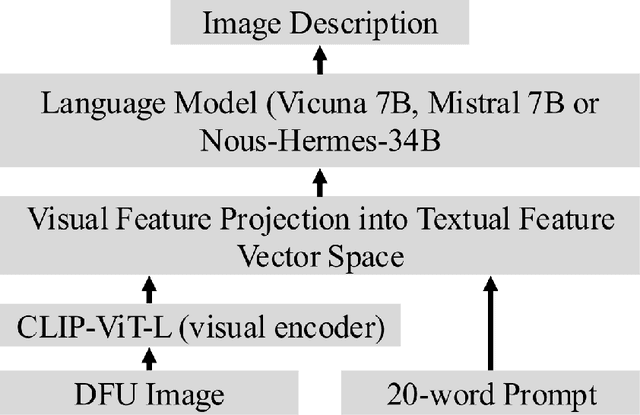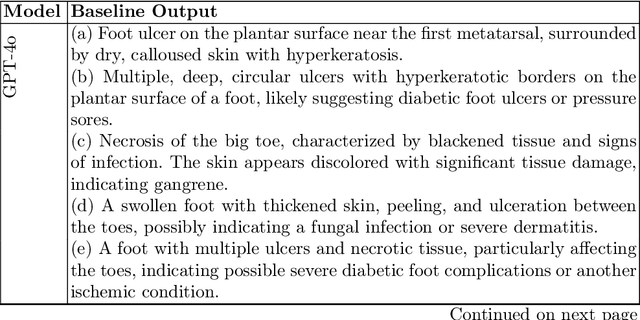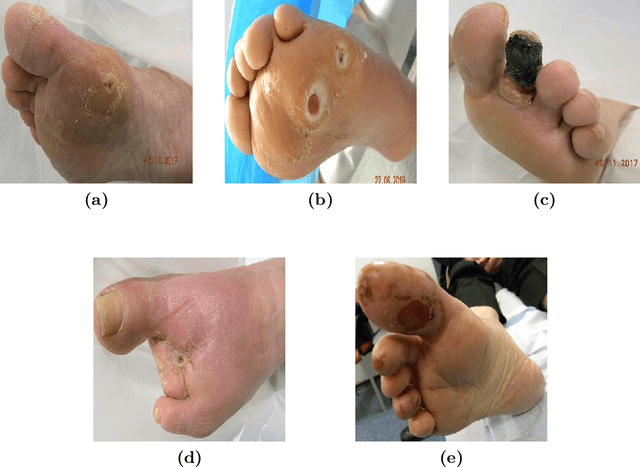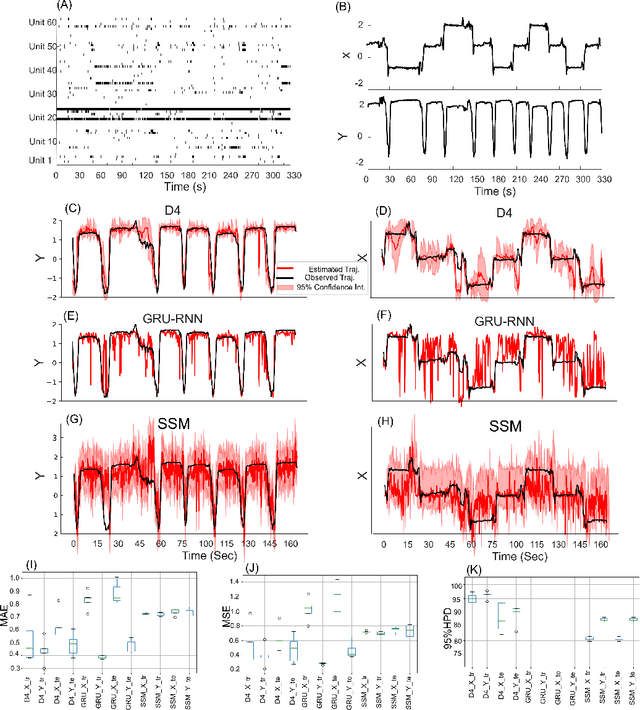Milos R. Popovic
UlcerGPT: A Multimodal Approach Leveraging Large Language and Vision Models for Diabetic Foot Ulcer Image Transcription
Oct 02, 2024



Abstract:Diabetic foot ulcers (DFUs) are a leading cause of hospitalizations and lower limb amputations, placing a substantial burden on patients and healthcare systems. Early detection and accurate classification of DFUs are critical for preventing serious complications, yet many patients experience delays in receiving care due to limited access to specialized services. Telehealth has emerged as a promising solution, improving access to care and reducing the need for in-person visits. The integration of artificial intelligence and pattern recognition into telemedicine has further enhanced DFU management by enabling automatic detection, classification, and monitoring from images. Despite advancements in artificial intelligence-driven approaches for DFU image analysis, the application of large language models for DFU image transcription has not yet been explored. To address this gap, we introduce UlcerGPT, a novel multimodal approach leveraging large language and vision models for DFU image transcription. This framework combines advanced vision and language models, such as Large Language and Vision Assistant and Chat Generative Pre-trained Transformer, to transcribe DFU images by jointly detecting, classifying, and localizing regions of interest. Through detailed experiments on a public dataset, evaluated by expert clinicians, UlcerGPT demonstrates promising results in the accuracy and efficiency of DFU transcription, offering potential support for clinicians in delivering timely care via telemedicine.
Implicit Dynamical Flow Fusion (IDFF) for Generative Modeling
Sep 22, 2024



Abstract:Conditional Flow Matching (CFM) models can generate high-quality samples from a non-informative prior, but they can be slow, often needing hundreds of network evaluations (NFE). To address this, we propose Implicit Dynamical Flow Fusion (IDFF); IDFF learns a new vector field with an additional momentum term that enables taking longer steps during sample generation while maintaining the fidelity of the generated distribution. Consequently, IDFFs reduce the NFEs by a factor of ten (relative to CFMs) without sacrificing sample quality, enabling rapid sampling and efficient handling of image and time-series data generation tasks. We evaluate IDFF on standard benchmarks such as CIFAR-10 and CelebA for image generation. We achieved likelihood and quality performance comparable to CFMs and diffusion-based models with fewer NFEs. IDFF also shows superior performance on time-series datasets modeling, including molecular simulation and sea surface temperature (SST) datasets, highlighting its versatility and effectiveness across different domains.
Domain-Specific Deep Learning Feature Extractor for Diabetic Foot Ulcer Detection
Nov 27, 2023Abstract:Diabetic Foot Ulcer (DFU) is a condition requiring constant monitoring and evaluations for treatment. DFU patient population is on the rise and will soon outpace the available health resources. Autonomous monitoring and evaluation of DFU wounds is a much-needed area in health care. In this paper, we evaluate and identify the most accurate feature extractor that is the core basis for developing a deep-learning wound detection network. For the evaluation, we used mAP and F1-score on the publicly available DFU2020 dataset. A combination of UNet and EfficientNetb3 feature extractor resulted in the best evaluation among the 14 networks compared. UNet and Efficientnetb3 can be used as the classifier in the development of a comprehensive DFU domain-specific autonomous wound detection pipeline.
* 5 pages, 2 figures, 3 tables, 2022 IEEE International Conference on Data Mining Workshops
Synthesizing Diabetic Foot Ulcer Images with Diffusion Model
Oct 31, 2023Abstract:Diabetic Foot Ulcer (DFU) is a serious skin wound requiring specialized care. However, real DFU datasets are limited, hindering clinical training and research activities. In recent years, generative adversarial networks and diffusion models have emerged as powerful tools for generating synthetic images with remarkable realism and diversity in many applications. This paper explores the potential of diffusion models for synthesizing DFU images and evaluates their authenticity through expert clinician assessments. Additionally, evaluation metrics such as Frechet Inception Distance (FID) and Kernel Inception Distance (KID) are examined to assess the quality of the synthetic DFU images. A dataset of 2,000 DFU images is used for training the diffusion model, and the synthetic images are generated by applying diffusion processes. The results indicate that the diffusion model successfully synthesizes visually indistinguishable DFU images. 70% of the time, clinicians marked synthetic DFU images as real DFUs. However, clinicians demonstrate higher unanimous confidence in rating real images than synthetic ones. The study also reveals that FID and KID metrics do not significantly align with clinicians' assessments, suggesting alternative evaluation approaches are needed. The findings highlight the potential of diffusion models for generating synthetic DFU images and their impact on medical training programs and research in wound detection and classification.
Supervised and Unsupervised Deep Learning Approaches for EEG Seizure Prediction
Apr 24, 2023



Abstract:Epilepsy affects more than 50 million people worldwide, making it one of the world's most prevalent neurological diseases. The main symptom of epilepsy is seizures, which occur abruptly and can cause serious injury or death. The ability to predict the occurrence of an epileptic seizure could alleviate many risks and stresses people with epilepsy face. Most of the previous work is focused at seizure detection, we pivot our focus to seizure prediction problem. We formulate the problem of detecting preictal (or pre-seizure) with reference to normal EEG as a precursor to incoming seizure. To this end, we developed several supervised deep learning approaches model to identify preictal EEG from normal EEG. We further develop novel unsupervised deep learning approaches to train the models on only normal EEG, and detecting pre-seizure EEG as an anomalous event. These deep learning models were trained and evaluated on two large EEG seizure datasets in a person-specific manner. We found that both supervised and unsupervised approaches are feasible; however, their performance varies depending on the patient, approach and architecture. This new line of research has the potential to develop therapeutic interventions and save human lives.
Deep Discriminative Direct Decoders for High-dimensional Time-series Analysis
May 22, 2022



Abstract:Dynamical latent variable modeling has been significantly invested over the last couple of decades with established solutions encompassing generative processes like the state-space model (SSM) and discriminative processes like a recurrent or a deep neural network (DNN). These solutions are powerful tools with promising results; however, surprisingly they were never put together in a unified model to analyze complex multivariate time-series data. A very recent modeling approach, called the direct discriminative decoder (DDD) model, proposes a principal solution to combine SMM and DNN models, with promising results in decoding underlying latent processes, e.g. rat movement trajectory, through high-dimensional neural recordings. The DDD consists of a) a state transition process, as per the classical dynamical models, and b) a discriminative process, like DNN, in which the conditional distribution of states is defined as a function of the current observations and their recent history. Despite promising results of the DDD model, no training solutions, in the context of DNN, have been utilized for this model. Here, we propose how DNN parameters along with an optimal history term can be simultaneously estimated as a part of the DDD model. We use the D4 abbreviation for a DDD with a DNN as its discriminative process. We showed the D4 decoding performance in both simulation and (relatively) high-dimensional neural data. In both datasets, D4 performance surpasses the state-of-art decoding solutions, including those of SSM and DNNs. The key success of DDD and potentially D4 is efficient utilization of the recent history of observation along with the state-process that carries long-term information, which is not addressed in either SSM or DNN solutions. We argue that D4 can be a powerful tool for the analysis of high-dimensional time-series data.
 Add to Chrome
Add to Chrome Add to Firefox
Add to Firefox Add to Edge
Add to Edge